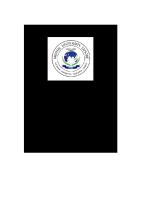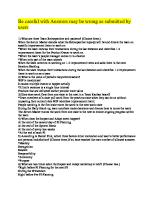Assignment: Submitted By: Submitted To: IFRAH ANUM: (18081517-020) Ma'Am Hamna Sohail BS (A.T.S.) 5 Semester [PDF]
ASSIGNMENT Annotation SUBMITTED BY: SUBMITTED TO: IFRAH ANUM: (18081517-020) MA’AM HAMNA SOHAIL BS (A.T.S.) 5TH SEM
26 0 174KB
Papiere empfehlen
![Assignment: Submitted By: Submitted To: IFRAH ANUM: (18081517-020) Ma'Am Hamna Sohail BS (A.T.S.) 5 Semester [PDF]](https://vdoc.tips/img/200x200/assignment-submitted-by-submitted-to-ifrah-anum-18081517-020-max27am-hamna-sohail-bs-ats-5-semester.jpg)
- Author / Uploaded
- Ifrah
Datei wird geladen, bitte warten...
Zitiervorschau
ASSIGNMENT Annotation
SUBMITTED BY:
SUBMITTED TO:
IFRAH ANUM: (18081517-020)
MA’AM HAMNA SOHAIL
BS (A.T.S.) 5TH SEMESTER
FACULTY OF ENGLISH DEPARTMENT OF ENGLISH UNIVERSITY OF GUJRAT JANUARY, 2021
Annotation What is corpus annotation? Corpus annotation is the practice of adding interpretative linguistic information to a corpus. For example, one common type of annotation is the addition of tags, or labels, indicating the word class to which words in a text belong. This is so-called part-of-speech tagging (or POS tagging), and can be useful, for example, in distinguishing words which have the same spelling, but different meanings or pronunciation. Different kinds of annotation: Apart from part-of-speech (POS) tagging, there are other types of annotation, corresponding to different levels of linguistic analysis of a corpus or text — for example: Phonetic annotation: Adding information about how a word in a spoken corpus was pronounced. prosodic annotation — again in a spoken corpus — adding information about prosodic features such as stress, intonation and pauses. syntactic annotation — e.g., adding information about how a given sentence is parsed, in terms of syntactic analysis into such units such phrases and clauses. Semantic annotation: Adding information about the semantic category of words — the noun cricket as a term for a sport and as a term for an insect belong to different semantic categories, although there is no difference in spelling or pronunciation. Pragmatic annotation: Adding information about the kinds of speech act (or dialogue act) that occur in a spoken dialogue — thus the utterance okay on different occasions may be an acknowledgement, a request for feedback, an acceptance, or a pragmatic marker initiating a new phase of discussion. Discourse annotation: Adding information about anaphoric links in a text, for example connecting the pronoun them and its antecedent the horses in: I'll saddle the horses and bring them round. [an example from the Brown corpus] Stylistic annotation: Adding information about speech and thought presentation (direct speech, indirect speech, free indirect thought, etc.) Lexical annotation: Adding the identity of the lemma of each word form in a text — i.e., the base form of the word, such as would occur as its headword in a dictionary (e.g., lying has the lemma LIE).
Reasons for Annotation: Annotation is undertaken to give 'added value' to the corpus. A glance at some of the advantages of an annotated corpus will help us to think about the standards of good practice these corpora require. Manual examination of a corpus What has been built into the corpus in the form of annotations can also be extracted from the corpus again, and used in various ways. For example, one of the main uses of POS tagging is to enhance the use of a corpus in making dictionaries. Thus lexicographers, searching through a corpus by means of a concordance, will want to be able to distinguish separate (verb) from separate (adjective), and if this distinction is already signalled in the corpus by tags, the separation can be automatic, without the painstaking search through hundreds or thousands of examples that might otherwise be necessary. Equally, a grammarian wanting to examine the use of progressive aspect in English (is working, has been eating, etc) can simply search, using appropriate search software, for sequences of BE (any form of the lemma) followed — allowing for certain possibilities of intervening words — by the ing-form of a verb. Automatic analysis of a corpus Similarly, if a corpus has been annotated in advance, this will help in many kinds of automatic processing or analysis. For example, corpora which have been POS-tagged can automatically yield frequency lists or frequency dictionaries with grammatical classification. Such listings will treat leaves (verb) and leaves (noun) as different words, to be listed and counted separately, as for most purposes they should be. Another important case is automatic parsing, i.e. the automatic syntactic analysis of a text or a corpus: the prior tagging of a text can be seen as a first stage of syntactic analysis from which parsing can proceed with greater success. Thirdly, consider the case of speech synthesis: if a text is to be read aloud by a speech synthesiser, as in the case of the 'talking books' service provided for the blind, the synthesiser needs to have the information that a particular instance of sow is a noun (= female pig) rather than a verb (as in to sow seeds), because this make a difference to the word's pronunciation. Re-usability of annotations Some people may say that the annotation of a corpus for the above cases is not needed, automatic processing could include the analysis of such features as part of speech: it is unnecessary thereafter to preserve a copy of the corpus with the built-in information about word class. This argument may work for some cases, but generally the annotation is far more useful if it is preserved for future use. The fact is that linguistic annotation cannot be done accurately and automatically: because of the complex and ambiguous nature of language, even a relatively simple annotation task such as POS-tagging can only be done automatically with up to 95% to 98% accuracy. This is far from ideal, and to obtain an optimally tagged corpus, it is necessary to undertake manual work, often on a large scale. The automatically tagged corpus afterwards has to be post-edited by a team of human beings, who may spend thousands of hours on it. The result of such work, if it makes the corpus more useful, should be built into a tagged version of the corpus, which can then be made available to any people who want to use the tagging as a
springboard for their own research. In practice, such corpora as the LOB Corpus and the BNC Sampler Corpus have been manually post-edited and the tagging has been used by thousands of people. The BNC itself — all 100 million words of it — has been automatically tagged but has not been manually post-edited, as the expense of undertaking this task would be prohibitive. But the percentage of error — 2% — is small enough to be discounted for many purposes. So, my conclusion is that — as long as the annotation provided is a kind useful to many users — an annotated corpus gives 'value added' because it can be readily shared by others, apart from those who originally added the annotation. In short, an annotated corpus is a sharable resource, an example of the electronic resources increasingly relied on for research and study in the humanities and social sciences. Multi-functionality If we take the re-usability argument one step further, we note that annotation often has many different purposes or applications: it is multi-functional. This has already been illustrated in the case of POS tagging: the same information about the grammatical class of words can be used for lexicography, for parsing, for frequency lists, for speech synthesis, and for many other applications. People who build corpora are familiar with the idea that no one in their right mind would offer to predict the future uses of a corpus — future uses are always more variable than the originator of the corpus could have imagined! The same is true of an annotated corpus: the annotations themselves spark off a whole new range of uses which would not have been practicable unless the corpus had been annotated. However, this multi-functionality argument does not always score points for annotated corpora. There is a contrary argument that the annotations are more useful, the more they are designed to be specific to a particular application.









